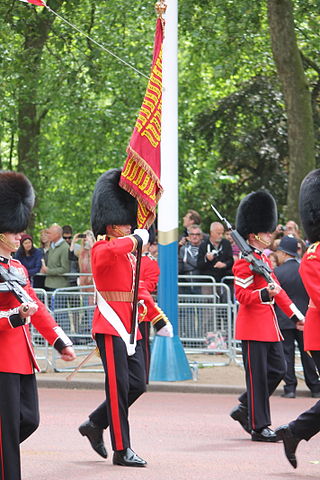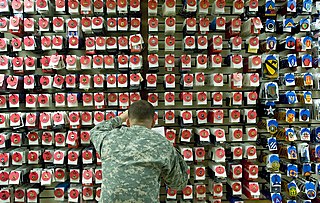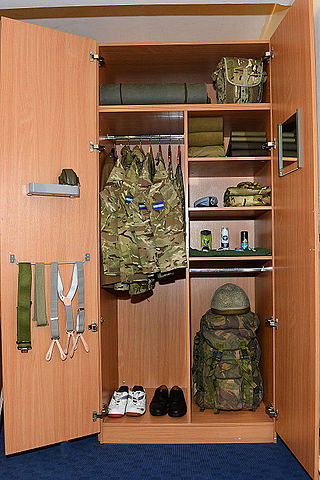
In military organizations, a colour guard is a detachment of soldiers assigned to the protection of regimental colours and the national flag. This duty is highly prestigious, and the military colour is generally carried by a young officer (ensign), while experienced non-commissioned officers are assigned to the protection of the national flag. These non-commissioned officers, accompanied in several countries by warrant officers, can be ceremonially armed with either sabres or rifles to protect the colour. Colour guards are generally dismounted, but there are also mounted colour guard formations as well.
Flag terminology is the nomenclature, or system of terms, used in vexillology, the study of flags, to describe precisely the parts, patterns, and other attributes of flags and their display.

The coat of arms of Canada, also known as the Royal Coat of Arms of Canada or, formally, as the Arms of His Majesty The King in Right of Canada, is the arms of dominion of the Canadian monarch and, thus, also the official coat of arms of Canada. In use since 1921, it is closely modelled after the royal coat of arms of the United Kingdom, with French and distinctive Canadian elements replacing or added to those derived from the British version.

A pipe band is a musical ensemble consisting of pipers and drummers. The term pipes and drums, used by military pipe bands is also common.

The Red Rose of Lancaster was the heraldic badge adopted by the royal House of Lancaster in the 14th century. In modern times it symbolises the county of Lancashire. The exact species or cultivar which it represents is thought to be Rosa gallica officinalis.

In military organizations, the practice of carrying colours, standards, flags, or guidons, both to act as a rallying point for troops and to mark the location of the commander, is thought to have originated in Ancient Egypt some 5,000 years ago. The Roman Empire also made battle standards reading SPQR a part of their vast armies. It was formalized in the armies of Europe in the High Middle Ages, with standards being emblazoned with the commander's coat of arms.

The Queen's Royal Hussars (The Queen's Own and Royal Irish) (QRH) is a British armoured regiment. It was formed on 1 September 1993 from the amalgamation of the Queen's Own Hussars and the Queen's Royal Irish Hussars. The regiment and its antecedents have been awarded 172 Battle Honours and eight Victoria Crosses. The regiment was based in Sennelager, Germany, until 2019 when it was relocated to Tidworth Camp, England. It is the armoured regiment for 20th Armoured Brigade Combat Team.

The Glengarry bonnet is a traditional Scots cap made of thick-milled woollen material, decorated with a toorie on top, frequently a rosette cockade on the left side, and ribbons hanging behind. It is normally worn as part of Scottish military or civilian Highland dress, either formal or informal, as an alternative to the Balmoral bonnet or Tam o' Shanter.

The Solomon Mahlangu Regiment is a reserve infantry regiment of the South African Army.

A cross pattée, cross patty, or cross paty, also known as a cross formy or cross formée, is a type of Christian cross with arms that are narrow at the centre, and often flared in a curve or straight line shape, to be broader at the perimeter. The form appears very early in medieval art, for example in a metalwork treasure binding given to Monza Cathedral by Lombard queen Theodelinda, and the 8th-century lower cover of the Lindau Gospels in the Morgan Library. An early English example from the start of the age of heraldry proper is found in the arms of Baron Berkeley.

The pipe major is the leading musician of a pipe band, whether military or civilian. Like the appointment of drum major, the position is derived from British Army traditions. During the early twentieth century, the term sergeant piper was used instead. The pipe major is often assisted by a pipe sergeant, who has similar duties in the band and leads the band in the absence of the pipe major.

A distinctive unit insignia (DUI) is a metallic heraldic badge or device worn by soldiers in the United States Army. The DUI design is derived from the coat of arms authorized for a unit. DUIs may also be called "distinctive insignia" (DI) or, imprecisely, a "crest" or a "unit crest" by soldiers or collectors. The U.S. Army Institute of Heraldry is responsible for the design, development and authorization of all DUIs.

The Lorne Scots is a Primary Reserve infantry regiment of the Canadian Army. It is part of the 4th Canadian Division's 32 Canadian Brigade Group.

The uniforms of the British Army currently exist in twelve categories ranging from ceremonial uniforms to combat dress. Uniforms in the British Army are specific to the regiment to which a soldier belongs. Full dress presents the most differentiation between units, and there are fewer regimental distinctions between ceremonial dress, service dress, barrack dress and combat dress, though a level of regimental distinction runs throughout.

The Cross of Burgundy is a saw-toothed form of the Cross of Saint Andrew, the patron saint of Burgundy, and a historical banner and battle flag used by holders of the title of Duke of Burgundy and their subjects.

In heraldry and vexillology, a heraldic flag is a flag containing coats of arms, heraldic badges, or other devices used for personal identification.

The royal standards of England were narrow, tapering swallow-tailed heraldic flags, of considerable length, used mainly for mustering troops in battle, in pageants and at funerals, by the monarchs of England. In high favour during the Tudor period, the Royal English Standard was a flag that was of a separate design and purpose to the Royal Banner. It featured St George's Cross at its head, followed by a number of heraldic devices, a supporter, badges or crests, with a motto—but it did not bear a coat of arms. The Royal Standard changed its composition frequently from reign to reign, but retained the motto Dieu et mon droit, meaning God and my right; which was divided into two bands: Dieu et mon and Droyt.
The Regimental Band and Pipes was founded on the Citadel campus in Charleston, South Carolina, in 1909, with marine general Harry K. Pickett in command. The marching band makes up one of the twenty-one companies of the South Carolina Corps of Cadets. In 1991, the band participated in the Edinburgh Military Tattoo in Scotland, becoming the first military college selected for the honor. They returned in 2010 as the only unit from the United States to appear at the Silver Jubilee of the Tattoo and appeared again in 2015.

Canadian military bands are a group of personnel in the Canadian Armed Forces (CAF) that performs musical duties for military functions. Military bands form a part of the Music Branch of the CAF, composed of six full-time professional Regular Force bands, 15 Regular Force voluntary bands, and 53 part-time reserve force bands. Bands of the Music Branch are often badged with the unit or Canadian Forces base insignia that they support.

The President's Colour Award is the highest honour that can be bestowed upon any military unit of India. It is also known as Nishaan, which is an emblem that is worn by all unit officers on the left-hand sleeve of their uniform.



















